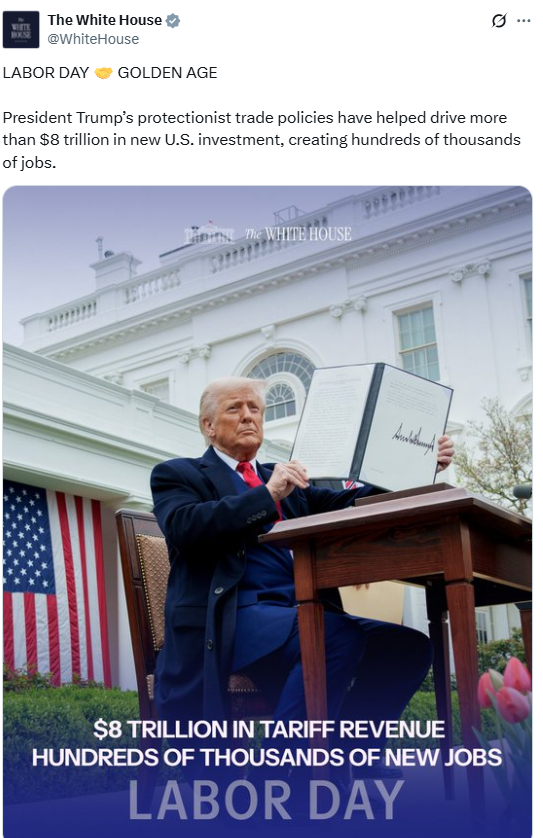|
||||||||||||||
|
Name
Cash Bids
Market Data
News
Ag Commentary
Weather
Resources
|
Trump Claims ‘$8 Trillion in Tariff Revenue’ Amid ‘Hundreds of Thousands of New Jobs’ in Confusing Labor Day Post
The official White House account on X (formerly Twitter) marked Labor Day with a celebratory post touting the success of President Donald Trump’s trade policies. The post, however, quickly sparked confusion and scrutiny after it claimed that tariffs had generated “$8 trillion in tariff revenue” for the United States. The image, featuring Trump outside the White House holding a signed document, included bold text reading, “President Trump’s protectionist trade policies have helped drive more than $8 trillion in new U.S. investment, creating hundreds of thousands of jobs”: 
The Numbers Don’t Add Up The main issue, however, is that $8 trillion in tariff revenue is highly implausible. According to the U.S. Treasury Department, total tariff collections during 2025 so far have amounted to $142 billion, however. While tariff revenues are on the rise, the amount is overstated by many multiples. By contrast, $8 trillion would equal nearly a third of the U.S. GDP — an amount impossible to generate from tariffs in such a short period. The image attached to the post is most likely a typo, as the original post states “President Trump’s protectionist trade policies have helped drive more than $8 trillion in new U.S. investment, creating hundreds of thousands of jobs.”
Official Communications?The discrepancy raises questions about the vetting of official White House communications. Posts on the administration’s official account are intended to represent official policy and data, and errors can have outsized political consequences. The wording of the caption suggests the administration may have meant to highlight investment rather than tariff revenue, but the graphic’s headline makes the distinction unclear. Critics argue this kind of confusion feeds misinformation about the actual impacts of tariffs, which remain a contentious political issue. Labor Day and the Politics of JobsThe timing of the post — on Labor Day — underscores the Trump administration’s effort to frame tariffs and trade wars as tools of economic nationalism and job creation. The White House claimed that Trump’s protectionist measures have spurred “hundreds of thousands of new jobs.” While tariffs have indeed led to certain domestic investments, studies show they also raised costs for U.S. businesses and consumers, with mixed results on employment. Independent reviews from the Congressional Budget Office and think tanks suggest the job benefits were modest and offset by losses in other sectors. On the date of publication, Caleb Naysmith did not have (either directly or indirectly) positions in any of the securities mentioned in this article. All information and data in this article is solely for informational purposes. For more information please view the Barchart Disclosure Policy here. |
|
|